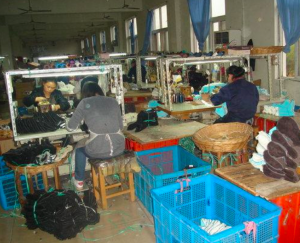Over the years, I noticed that it is possible to lump most factories in one of four categories:
- Level 1: the recently-created and u
 nstructured workshop;
nstructured workshop; - Level 2: the semi-organized factory that got out of level 1 but that is still struggling to keep quality & timing under control;
- Level 3: the factory that made big efforts to get organized, with the objective of pleasing large customers;
- Level 4: that rare bird that applies lean manufacturing, and that avoids level 3’s rigidity.
In this article I am excluding Chinese state-owned enterprises, which are a breed on their own.
Most manufacturers are at level 1 or level 2:
Level 1: the unstructured workshop
Typical profile:
- 0-200 workers, engaged in simple processing (often assembly);
- Managed by the owner and his family;
- No quality system, no quality control staff;
- No ability or time to work on complex prototypes before production starts;
- Focused only on “making production” fast and on the cheap;
- Can accept small orders, as long as purchasing components in small quantity is possible;
- Seldom works directly for export customers;
- Count on other manufacturers or trading companies to get business.
Result: very low costs and low MOQs, but needs to be followed very closely by customers.
Level 2: the semi-organized manufacturer
This category is a mixed bag. Some export 100% of their output and are very familiar with their market’s quality & safety standards. Others focus more on the domestic market or the most price-sensitive countries (Middle East, India…), and should be avoided by importers from North America and Europe.
Still, it is possible to draw a somewhat typical profile:
- 200-800 workers
- Has grown out of the “disorganized workshop” stage
- Has had to hire a few professional managers because of the growing complexity of operations
- Has had to hire a few QC employees, to avoid big disasters
- But still, low concern for quality among staff and managers (in most cases)
- May have English-speaking salespeople if direct relationships with foreign customers is a goal
- May still get orders mostly from trading companies and other factories
Result: costs are relatively low, and quality & timing are relatively unstable. The owner’s motivation for your orders still determines their reliability.
Level 3: the organized manufacturer
Typical profile: 800+ workers, owner is often from Taiwan or Hong Kong.
They have tried hard to comply with demanding buyers’ requirements:
- Every aspect of production is specified in detail;
- Production is checked thoroughly by QC department;
- Hopefully, strong staff discipline to follow the system;
- Customers’ IP rights are more strictly respected.
I described this type of company in more details here.
Result: few quality issues, but high indirect labor costs (QC, middle management) and low flexibility.
Level 4: the continuously improving manufacturer
Typical profiles:
- Part of a large multinational group, or
- Midsize factory with a process-oriented general manager.
They follow the lean model:
- Regular improvements to material flow and to each processes;
- Errors are prevented or corrected at the source;
- Staff is trained and supports the philosophy.
Result: high customer satisfaction (close to zero defects; production cycle below 5 days) and relatively low cost (high productivity of operators, limited QC staff and rework).
Unfortunately, these companies are a very small minority. They usually don’t advertise themselves on B2B directories. They are very hard to find.
What kind of Chinese factories should you work with?
First, a couple of rules to keep in mind:
- If you work with a supplier that is too large relative to your orders (e.g. you would occupy 1% of their annual capacity), you will be quoted high prices and given poor service.
- If you work with a small supplier that cannot produce the quantities you order, they will be forced to subcontract production and you will probably be in for a disaster.
My general advice would be as follows:
- If your orders are very small, you might need to work with a trading company that will place your orders in a level 1 factory and follow production.
- If your orders are large enough to work directly with a manufacturer, but not big enough to be interesting to big factories, go for level 2.
- If your order are considered large and even big companies actively fight for your business, go for level 3.
- If you are in a very quality-sensitive industry and you cannot afford even 1% of defects, spend time and search for level 4 (but you might not find any in your vertical).
What do you think?
–
PS: if you liked this article, you can subscribe so that you receive future articles by email. Just click here. Thanks!

 nstructured workshop;
nstructured workshop;
Excellent analysis, Renaud. I have encountered examples of each type. Unfortunately, due to my size, I tend to focus on #2 or, if lucky, #3. Usually #4 will not talk to me, even when I find them. It is never via b2b trade websites, almost always by sheer accident.
Yes that makes sense. Thanks Callum.
How do you find out what level a business is
By visiting it. If you can’t visit it yourself, we can help you and audit it. See https://www.sofeast.com/factory-auditing/.
Is this valid for every/any product?
Good question. Yes, more or less.
The garment industry is a bit different. I have seen some very good factories with only 200 workers. I touched on it in https://www.qualityinspection.org/garment-industry/